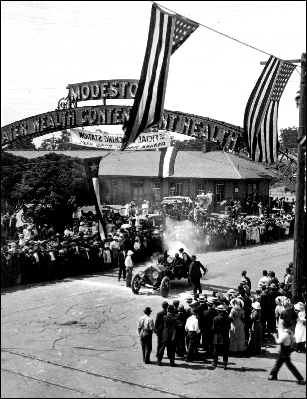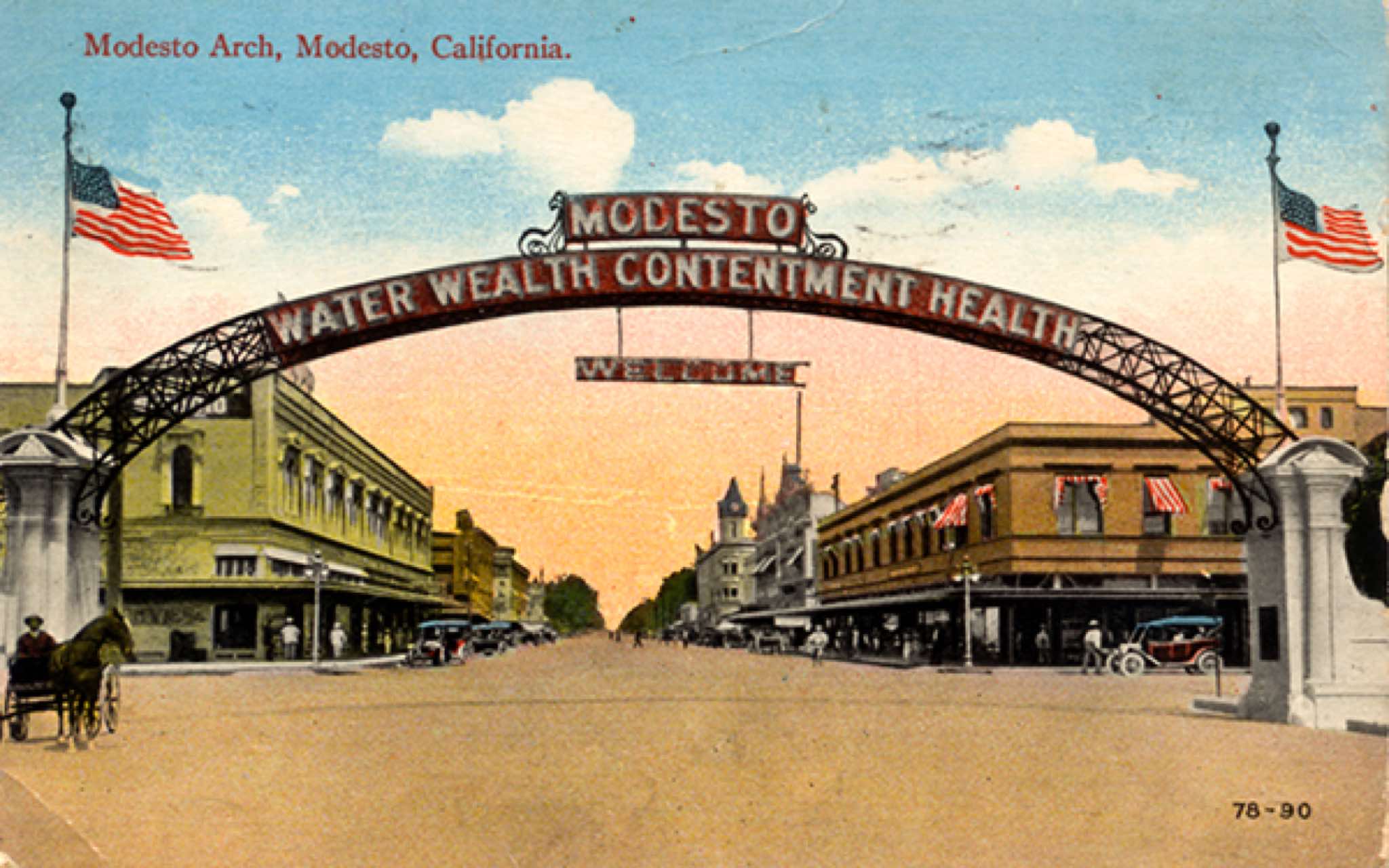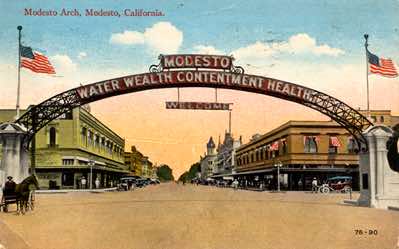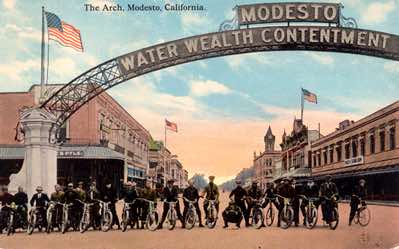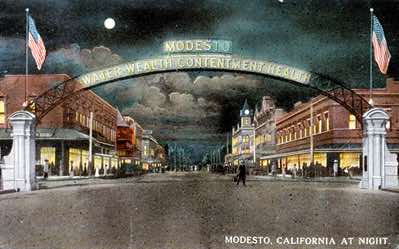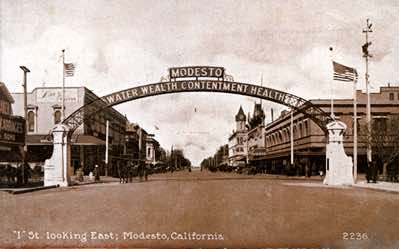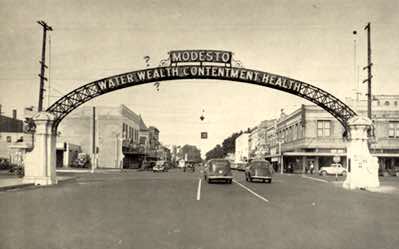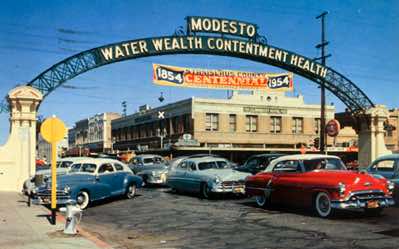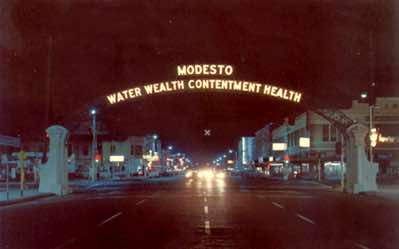The Panama Pacific Road Race in 1913 brought cars under the year-old arch on the Fourth of July. The race was 444 miles from Los Angeles to Sacramento with cars reaching speeds of 110 miles an hour. A Barney Oldfield driver, Frank Verbeck, won the race in a Fiat. Next: Landmarks/A Place to Stay/Hotel Modesto Previous: 20th Century/Sports/The Relays |
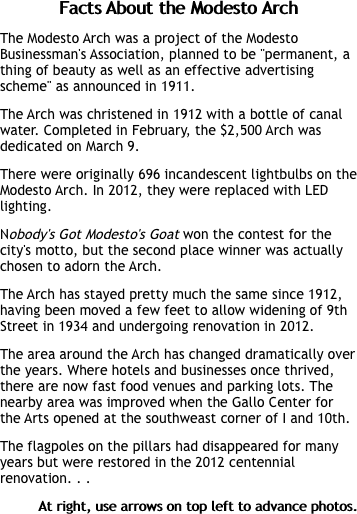
The Memorial Arch of Prosperity
Tinkham's 1921 county history doesn't spend a great deal of space for a discussion of the Modesto Arch, but there is a mention as follows:
"The leading citizens of the city, including the women, believed it would be an excellent idea to erect ornamental structures along the leading streets of the city beginning on I Street. The idea met with a hearty approval and in May, 1911, the business men assembled in Schafer's hall and the committee reported a design shown in water colors. It was not satisfactory, for in August they offered a price of fifty dollars for the 'best design or arch over I Street near the depot.' A design was selected and erected in 1912. The arch spans I Street at the intersection of Front Street. It is constructed of structural steel and rests on two solid granite pillars twelve feet in height. It is seventy-five feet in width and twenty-five feet center height. The money was obtained by subscriptions, varying in amount from five dollars to one hundred dollars, and cost something like $1,200. In the bow of the arch are these words that may be read from either side, Water, Wealth, Contentment, Health. The arch can be illuminated at night and in four words it tells the story of the condition of Stanislaus County since the Sierras' waters began irrigating the land."
In an August, 1911 article headlined, "Elaborate Arch Will Span Modesto's Main Business Thoroughfare," the Modesto News reports the decision to choose a design submitted by Architect Bernard J. Joseph, who would later design the Hotel Hughson, as well:
"The arch as shown in the illustration will be one of the most elaborate possible. It will cost in the neighborhood of $2,000, and has been designed by Architect Bernard J. Joseph of this city and San Francisco. Architect Joseph is considered to be one of the finest on the Pacific Coast, and that he entered the contest of the Businessmen's association is only an indiction of his desire to aid this city in attracting the traveler."
It would be Joseph's assistant, Clarence Dakin, who managed a somewhat overzealous statement when talking about the design, stating, "We purposely made this arch elaborate. We believed that Modesto should have something that any city might be proud of. Paris itself would not sneer at an arch such as this. You intend to place the word 'wealth' on the arch. Therefore you do not want something that looks like it cost a nickel."
Unique, both loved and reviled, the Modesto Arch almost met the fate of other city landmarks in the 1960s when a proposal was floated to remove it. Citizens were not pleased and the Arch remained across I Street as an icon of the once active downtown core. There will always be those who are skeptical of its worth. One of the stories heard often is that Eleanor McClatchy, publisher of The Modesto Bee, so disliked the arch that she banned its picture from being used in the newspaper.
But the Modesto Arch has outlived Mrs. McClatchy, and routinely is used as a backdrop for news reports from Modesto. It gained notoriety nationwide during several unpleasant periods of crime that reverberated throughout the country in the late 1990s and early 2000s. Every report on televisiion seemed to start with a reporter standing in front of the Arch, which stood silently in the background as incriminating proof of where these heinous crimes had taken place.
More recently, the city has seen a nostalgic upsurge in appreciation for the over 100 year old structure and a certain amount of civic pride. In a city not known for preserving its landmarks, a major renovation of the Arch was undertaken in 2012 bringing it back to its original lustre with a few modern touches, such as LED lighting. So, after a century, the Arch continues to bear witness to Modesto's past and a brighter future, courtesy of those LEDs
.

